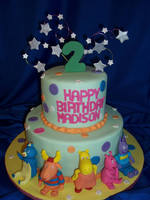
How to Set Prices for Your Decorated Cakes
Cake Decorating and Pricing Tips
Many people who handcraft their own decorated cakes don’t charge for the time they invest in the cake. Maybe they feel because the cake is made in their own kitchen, that it is not worth the high price of a bakery cake. For whatever reason, a person who makes cakes in their home often believe their craft is inferior to cakes created in the bakery section of a local store.
But, the cake you bake and decorate is no less a thing of beauty than any cake you find in your local bakery. Decorated cakes can be found in a variety of grocery stores, and they are decorated by hourly wage people that may or may not have had previous decorating experience.
Look at some of the handwriting on store bought cakes. It isn’t perfect, in fact sometimes the words are misspelled or placed incorrectly. On the other hand, you take the time to make everything as perfect as possible, you care about the product you make, and deserve to receive as much compensation for your work than anyone else.
Often, people who are just starting a cake decorating business offer lower prices than bakery shops. This is a big mistake! Actually, your prices should be slightly higher than the ones sold in stores. Most likely you precisely place the decorations on the cake, carefully write the message on the cake, and never take shortcuts when it comes to presenting the customer with a more personable cake than they’d get from a store.
Don’t under price your works of art, and don’t set your prices below the cakes found in bakery shops. Setting low prices might be your way to attract business, but people who are shopping for birthday or wedding cakes will question the low price. In effect, you can be eliminating yourself from the competition with low prices, because customers might think the quality of your cakes will be inferior.
Of course, when you first start in the cake decorating business, you need to set the prices comparable to other cake bakers in your local community. Never, never under price your cakes and set them apart from the going prices set from specialty bakers. The reason someone comes to you is because they are looking for a better product or a technique that bakers will not or cannot provide. Then as you gain experience and improve your techniques, you can steadily increase the price of your specialty designed cakes.
Setting your cake decorating prices too low, can actually price yourself right out of business! Sure, you might get many orders for decorated cakes, but if you lose money on every one, how long will you be able to stay in business? Your cakes might be beautiful and unique, but if you are not being paid the true worth than you might as well just close your doors.
In addition to supplies, you must be compensated for your time, as well. Before setting a price, you need to take into consideration the time it takes to mix the cake, bake the cake, mix the icing, make the decorations and decorate the cake. For instance, if a customer wants a custom design, then you need to figure the cost of supplies, an hour to mix and make the cake, maybe another two hours to make the decorations, and another hour to decorate the cake. If you believe your time is worth $5 or $10 per hour, then the price of the cake should be a minimum of $40 to $60. Do not under compensate yourself.
Sure, cake decorating might begin as a hobby to present cakes to family members or friends and neighbors. But, before long, the word gets out about your skills and it turns into a business. You need to be smart about what you’re doing or it will become a drain on your time and finances.
In addition to cake and icing ingredients, cake decorating tips, cutters, colors, bags, racks, mixers, tables and classes to learn more or advanced techniques do not come free. You must charge a reasonable amount in order to buy the tools of the trade. No one can tell you how much to charge for a decorated cake. You need to be comfortable with the prices you charge. But, do your homework, learn how much bakers are charging for designed cakes in your community.
Compile a gallery of photos so customers can see the work you’ve done, and can feel confident in the product you have to offer. Here again, if your work is substandard to local bakeries, then why should customers pay more to buy their cake from you? Photographs, good quality cakes, and unique designs are important in order to set your price a bit higher than store bakeries. Always strive to do better work, maintain good tasting cakes and icings, and give personable, caring service to your customers.

